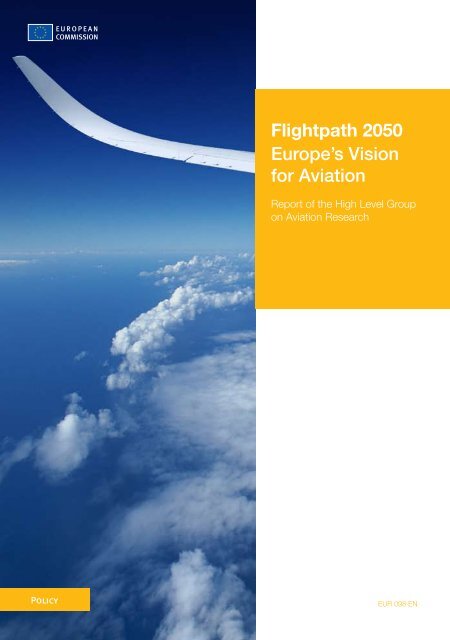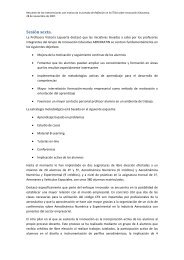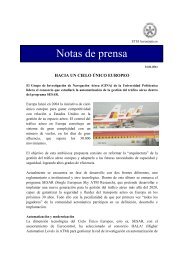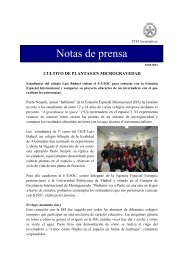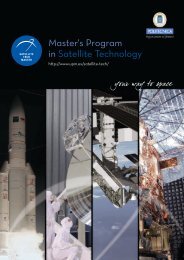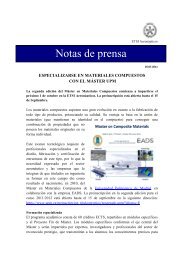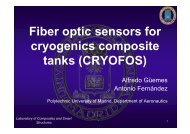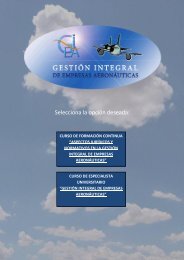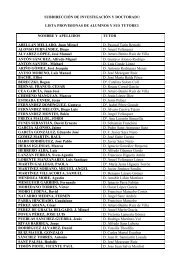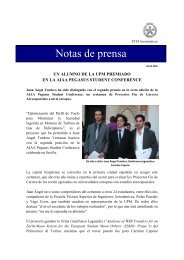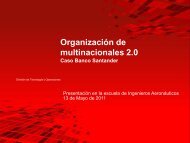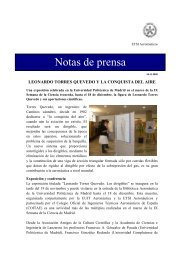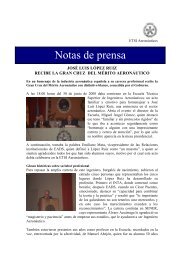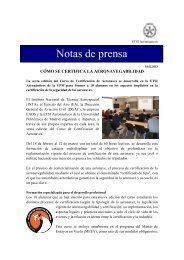Flightpath 2050 - European Commission - Europa
Flightpath 2050 - European Commission - Europa
Flightpath 2050 - European Commission - Europa
Create successful ePaper yourself
Turn your PDF publications into a flip-book with our unique Google optimized e-Paper software.
EUROPEAN<br />
COMMISSION<br />
<strong>Flightpath</strong> <strong>2050</strong><br />
Europe’s Vision<br />
for Aviation<br />
Report of the High Level Group<br />
on Aviation Research<br />
Policy<br />
EUR 098 EN
EUROPEAN COMMISSION<br />
Directorate-General for Research and Innovation<br />
Directorate General for Mobility and Transport<br />
EUROPE DIRECT is a service to help you find answers<br />
to your questions about the <strong>European</strong> Union<br />
Freephone number (*):<br />
00 800 6 7 8 9 10 11<br />
(*) Certain mobile telephone operators do not allow access to 00 800 numbers<br />
or these calls may be billed<br />
LEGAL NOTICE<br />
Neither the <strong>European</strong> <strong>Commission</strong> nor any person acting on behalf of the <strong>Commission</strong> is responsible<br />
for the use which might be made of the following information.<br />
The views expressed in this publication are the sole responsibility of the author and do not necessarily<br />
reflect the views of the <strong>European</strong> <strong>Commission</strong>.<br />
More information on the <strong>European</strong> Union is available on the Internet (http://europa.eu).<br />
Cataloguing data can be found at the end of this publication.<br />
Luxembourg: Publications Office of the <strong>European</strong> Union, 2011<br />
ISBN 978-92-79-19724-6<br />
doi 10.2777/50266<br />
© <strong>European</strong> Union, 2011<br />
Reproduction is authorised provided the source is acknowledged.<br />
Printed in Belgium<br />
PRINTED ON ELEMENTAL CHLORINE-FREE BLEACHED PAPER (ECF)
EUROPEAN COMMISSION<br />
<strong>Flightpath</strong> <strong>2050</strong><br />
Europe’s Vision for Aviation<br />
Maintaining Global Leadership &<br />
Serving Society’s Needs<br />
Report of the High Level Group on Aviation Research<br />
2011<br />
Directorate-General for Research and Innovation<br />
Directorate-General for Mobility and Transport<br />
1
Aviation – an invaluable asset for Europe<br />
The <strong>European</strong> Aviation Vision <strong>2050</strong><br />
Highly ambitious goals<br />
<strong>European</strong> air transport in <strong>2050</strong><br />
Meeting societal & market needs<br />
Maintaining and extending industrial<br />
leadership<br />
Protecting the environment and the<br />
energy supply<br />
Ensuring safety and security<br />
Prioritising research, testing capabilities<br />
& education<br />
Achieving the Vision<br />
A research and innovation friendly<br />
environment for Europe<br />
From Vision to the Research Agenda<br />
4<br />
7<br />
7<br />
8<br />
10<br />
12<br />
14<br />
16<br />
18<br />
20<br />
20<br />
22<br />
The High Level Group<br />
on Aviation Research<br />
Marek Darecki<br />
Charles Edelstenne<br />
Tom Enders<br />
Table of<br />
Contents<br />
Emma Fernandez<br />
Peter Hartman<br />
Jean-Paul Herteman<br />
Michael Kerkloh<br />
Ian King<br />
Patrick Ky<br />
Michel Mathieu<br />
Giuseppe Orsi<br />
Gerald Schotman<br />
Colin Smith<br />
Johann-Dietrich Wörner<br />
2
Foreword<br />
by Siim Kallas, Vice-President of the <strong>European</strong> <strong>Commission</strong> and <strong>Commission</strong>er for Transport, and<br />
Máire Geoghegan-Quinn, <strong>Commission</strong>er for Research, Innovation and Science<br />
Europe is entering a new age where it faces many challenges such as globalisation, a<br />
financial system in need of reform, climate change and an increasing scarcity of resources.<br />
This is why the <strong>European</strong> air transport system is directly concerned by new challenges<br />
regarding its competitiveness, performance and sustainability. The <strong>European</strong> manufacturing<br />
and service industry is strongly affected by globalisation, new competitors, new markets and<br />
the need for innovation. Sustainable mobility is at stake, as are millions of jobs and billions of<br />
Euros of added value. Research and innovation are key to maintaining Europe’s capacities and<br />
competitiveness and it is time to align efforts towards a new long-term vision for this sector.<br />
We invited key stakeholders of <strong>European</strong> aviation from the aeronautics industry, air traffic<br />
management, airports, airlines, energy providers and the research community to come<br />
together in a High Level Group to develop a vision for Europe’s aviation system and industry<br />
by <strong>2050</strong>. The aviation community responded enthusiastically and produced this important<br />
document which focuses on two main challenges: meeting the needs of our citizens and the<br />
market as well as maintaining global leadership.<br />
The strategy addresses customer orientation and market needs as well as industrial<br />
competitiveness and the need to maintain an adequate skills and research infrastructure<br />
base in Europe. By <strong>2050</strong>, passengers and freight should enjoy efficient and seamless travel<br />
services, based on a resilient air transport system thoroughly integrated with other transport<br />
modes and well connected to the rest of the world. This will be necessary in order to meet the<br />
growing demand for travel and to cope more easily with unforeseeable events.<br />
It should also help to reduce aviation’s impact on citizens and the environment. Aviation has<br />
an important role to play in reducing noise as well as greenhouse gas emissions, regardless of<br />
traffic growth. Aviation must move towards more sustainable energy sources. It should live up<br />
to the highest levels of safety and security to ensure that passengers and freight as well as the<br />
air transport system and its infrastructure are protected.<br />
The vision set out in this document stresses the need for an innovation friendly environment<br />
relying on strong, sustainable and coherent investment in research and innovation and<br />
enhanced governance, funding and financing structures.<br />
Research, technology and innovation are essential catalysts for a competitive and sustainable<br />
future and we need to start quickly to be effective. This document setting out a <strong>European</strong><br />
vision for the future of aviation emphasises where those working in aviation see the priorities<br />
for the relevant policy, research and innovation instruments. It is a high-level vision of Europe<br />
leading with an aviation industry that is clean, competitive, safe and secure.<br />
Siim Kallas<br />
Máire Geoghegan-Quinn<br />
3
Aviation - an invalubale<br />
asset for Europe<br />
Aviation –<br />
an invaluable<br />
asset for Europe<br />
Aeronautics and air transport 1 is a vital sector of<br />
our society and economy. It is also of sovereign<br />
importance for the <strong>European</strong> Union and its Member<br />
States. It is a sector in which <strong>European</strong> public and<br />
private stakeholders provide world leadership and<br />
helps to meet society’s needs by:<br />
• ensuring suitable and sustainable mobility of<br />
passengers and freight<br />
• generating wealth and economic growth<br />
• significantly contributing to the balance of trade and<br />
<strong>European</strong> competitiveness<br />
• providing highly skilled jobs and innovation<br />
• fostering Europe’s knowledge economy through<br />
substantial R&D investment<br />
• contributing in many ways to global safety, security<br />
and self-reliance.<br />
Aviation is a catalyst for growth and skilled employment. As<br />
such, it is at the heart of the EUROPE 2020 strategy and its<br />
flagship initiatives including: Innovation Union, An industrial<br />
policy for the globalisation era and Resource Efficient Europe.<br />
Aviation’s economic and societal contribution is substantial<br />
generating around €220 billion 2 and providing 4.5 million<br />
jobs 3 . The value of this contribution is illustrated by the<br />
economic impact of the disruption to the <strong>European</strong> air<br />
transport system of 2010’s volcanic eruption in Iceland which<br />
amounted to approximately €2.5 billion in the first week.<br />
Over the past 40 years, the <strong>European</strong> aeronautic industry<br />
has, through collective <strong>European</strong> efforts encompassing<br />
public and private, major companies, thousands of small<br />
and medium enterprises (SMEs), academia and research<br />
laboratories, successfully raised from a niche sector to<br />
a world leading industry. Its products include aircraft,<br />
rotorcraft, engines, avionics and systems as well as<br />
leading operations and services. Aeronautics therefore<br />
continues to be a highlight of an integrated high<br />
technology research, development and manufacturing<br />
sector. It numbers approximately 82000 aeronautical<br />
companies 4 , including a significant share of small and
medium-sized enterprises which in 2009 supported<br />
about 500000 sustainable and highly skilled jobs. In the<br />
same year, aeronautics generated a turnover in excess<br />
of €100 billion, of which approximately 60% is exported<br />
outside the <strong>European</strong> Union.<br />
On average, 12% of aeronautic revenues, representing<br />
almost €7 billion per year for civil aeronautics alone,<br />
are reinvested in Research and Development (R&D)<br />
and support around 20% of aerospace jobs. Every Euro<br />
invested in aeronautics R&D creates an equivalent<br />
additional value in the economy every year thereafter.<br />
Aeronautical technologies are catalysts for innovation<br />
and spill-over into other economic and technological<br />
sectors, thus contributing to the growth of the <strong>European</strong><br />
economy as a whole.<br />
Aviation is a vital facilitator of <strong>European</strong> integration<br />
and cohesion by providing essential transport links.<br />
It is an important enabler of prosperity and wealth<br />
creation for the Member States and their peripheral<br />
regions by stimulating development, opening new<br />
markets, boosting international trade and encouraging<br />
companies to invest.<br />
Europe is home to approximately 150 scheduled<br />
passenger airlines and 450 airports, which in 2009<br />
supported 751 million passengers 5 . World wide, traffic is<br />
predicted to grow at a rate of close at 4-5% per year with<br />
even higher growth rates 6 in the Middle East and Asia.<br />
5
The aviation sector is also fully aware of its responsibilities<br />
towards Europe’s citizens: protection of the environment,<br />
security and safety. It is meeting these challenges<br />
successfully and so enabling its continued contribution<br />
to <strong>European</strong> economic and societal well-being.<br />
Challenges<br />
However, the industrial competition is becoming ever<br />
fiercer from established, traditional rivals such as the US<br />
and even more so from new and strong challengers,<br />
notably Brazil, Canada, China, India and Russia. Regions<br />
such as the Middle East and Asia at large have emerged<br />
as strong competitors for air services and infrastructure.<br />
Authorities in these countries have understood the<br />
strategic nature of aviation and support their industries<br />
accordingly, enhancing competition at all levels.<br />
Europe must succeed despite this increased competition.<br />
For that to happen, Europe must address three key<br />
challenges: increase the level of technology investment,<br />
enhance its competitiveness in world air transport<br />
markets and accelerate the pace of policy integration.<br />
Technological leadership, the root of Europe’s current success,<br />
will continue to be the major competitive differentiator.<br />
Break-through technology will be required to secure<br />
future competitive advantage, most notably in terms of<br />
energy, management of complexity and environmental<br />
performance. Substantial and sustained investment in the<br />
technologies of today and tomorrow is needed to guarantee<br />
the future, as well as readiness to spin-in advances arising<br />
from defence investment where appropriate.<br />
This is not only a matter of success but also of survival.<br />
Aviation will be as valuable for future <strong>European</strong><br />
generations as it is for ours.<br />
Opportunity<br />
Europe must seize the opportunity of the expanding<br />
aviation market, and preserve its pre-eminent position to<br />
ensure the continued success and economic contribution<br />
of its aviation industry in <strong>European</strong> and export markets.<br />
With its leading knowledge and manufacturing<br />
capability, the <strong>European</strong> aviation industry is in a position<br />
to define and shape a sustainable future.<br />
Remaining competitive is also about the timely delivery<br />
of competitive products and services. It is linked to a<br />
common level playing field of government support,<br />
which requires policy action to redress distortions and<br />
facilitate a favourable environment for innovation.<br />
Building on the vision 7 for 2020, and the ensuing ACARE<br />
initiative, this document lays out our vision for <strong>European</strong><br />
aviation to <strong>2050</strong>. Today and even more so tomorrow, a<br />
safe and efficient Air Transport System, led by innovative<br />
technology, will be a vital vector for our economy, our<br />
society and the cohesion of Europe and the world<br />
Our Vision<br />
The <strong>European</strong> aviation community leads the world<br />
in sustainable aviation products and services,<br />
meeting the needs of EU citizens and society.<br />
1<br />
Aeronautics and air transport comprises both: air vehicle<br />
and system technology, design and manufacture; and also<br />
the constituent parts of the overall air travel system (aircraft,<br />
airlines, general aviation, airports, air traffic management,<br />
and maintenance, repair and overhaul) as well as many nontransport<br />
applications of aircraft, such as search and rescue.<br />
For convenience this is collectively called Aviation in this<br />
document<br />
2<br />
The economic and social benefits of air transport 2008, Air<br />
Transport Action Group (ATAG)<br />
3<br />
Delivering a bright future for <strong>European</strong> Aviation and Passengers.<br />
5 year Strategic Plan 2010-2014. Association of <strong>European</strong><br />
Airlines<br />
4<br />
Source: ASD Facts and Figures, 2009<br />
5<br />
Source: Eurostat<br />
6<br />
Source: Airbus Global market forecast 2010-2029<br />
7<br />
<strong>European</strong> Aeronautics: A Vision for 2020. Meeting society’s<br />
needs and winning global leadership. Report Of The Group<br />
Of Personalities, January 2001<br />
6
The <strong>European</strong><br />
Aviation Vision<br />
<strong>2050</strong><br />
<strong>European</strong> Aviation<br />
Vision <strong>2050</strong><br />
Highly ambitious goals<br />
Aviation serves the citizen, brings people together and<br />
delivers goods through seamless, safe and secure, cost<br />
effective transport chains, adding value through speed,<br />
reliability and resilience in a global network, over any<br />
distance, without negative effects on the environment.<br />
Aviation also contributes to society in other critical, nontransport<br />
areas such as emergency services, search and<br />
rescue, disaster relief and climate monitoring.<br />
Our Vision for the <strong>European</strong> aviation is extensive, holistic,<br />
highly ambitious and built on the parallel objectives of:<br />
Maintaining global leadership:<br />
• Providing the best products and associated<br />
services in aeronautics and air transport<br />
• Ensuring the competitiveness of <strong>European</strong><br />
industry, supported by a strong research network<br />
and balanced regulatory framework, in the face<br />
of fierce competition from both established and<br />
emerging rivals<br />
• Maximising the aviation sector’s economic<br />
contribution and creating value:<br />
• directly from aviation manufacturing, equipment,<br />
systems and services;<br />
• indirectly by creating demand up the supply chain,<br />
involving SMEs and based on cutting-edge research<br />
and education;<br />
• catalytically by providing the connectivity needed<br />
by other globalised industries and trade.<br />
• Attracting the best people and talents<br />
• celebrating and publicising the success of the<br />
sector to create and sustain excitement around the<br />
<strong>European</strong> Aviation Vision.<br />
Serving society’s needs<br />
• Meeting societal and market needs for affordable,<br />
sustainable, reliable and seamless connectivity for<br />
passengers and freight with sufficient capacity<br />
7
• Supporting the integration and cohesion of the<br />
<strong>European</strong> Union, its neighbours and partners<br />
• Addressing societal needs with non-transport<br />
aerial applications enabled by new flight control<br />
technologies<br />
• Protecting the environment and enabling the<br />
use of sustainable energy and alternative energy<br />
sources<br />
• Ensuring complete and non-intrusive security<br />
• Ensuring safety<br />
• Providing opportunities for highly qualified and<br />
skilled jobs in Europe.<br />
The following pages describe our Vision, in terms of how<br />
the world will be, for <strong>European</strong> aviation in <strong>2050</strong>.<br />
<strong>European</strong> air transport in<br />
<strong>2050</strong><br />
Global Position<br />
In <strong>2050</strong>, the <strong>European</strong> air transport system is integrated<br />
in a complete logistical transport chain and part of a fully<br />
interconnected, global aviation system that is based on<br />
a multilateral regime rather than on a series of bilateral<br />
agreements. Interoperability between Europe and<br />
the other regional components of the global network<br />
is complete. Commercial air transport services are<br />
provided mainly by airlines organised as a few global<br />
alliances. Thanks to tight links between technological<br />
and regulatory approach, Europe has a global lead in<br />
the implementation of international standards covering<br />
all aviation issues, including interoperability, the<br />
environment, energy, security and safety. This leadership<br />
ensures that the global regulatory system enables market<br />
access and free, fair and open competition.<br />
Outside Europe, the currently emerging economies<br />
have developed and become established. Europe,<br />
along with the United States, is now one of several<br />
economic powerhouses alongside Brazil, Russia, India<br />
and China. Population and economic growth has<br />
increased the global volume of traffic markedly, to<br />
around 16 billion passengers annually (compared to the<br />
2.5 billion passengers in 2011). The exploitation of the<br />
best air mobility options - diverse routes, locations and<br />
flight levels - for passenger and freight transport avoids<br />
airspace congestion and bottlenecks.<br />
In <strong>2050</strong>, the diversity of air vehicles operating in common<br />
blocks of airspace is many-fold, including: a range of<br />
next generation wide and narrow body commercial<br />
aircraft, executive aircraft, advanced rotorcraft of all types<br />
including tilt-rotors, specialised aircraft (quiet shorttake-off<br />
and landing (QSTOL), regional, business) and<br />
remotely controlled unmanned aircraft systems (UASs).<br />
A proportion of these vehicles are pilotless and some<br />
are autonomous. Non-transport aviation missions have<br />
increased significantly and are undertaken by remotely<br />
controlled and autonomous vehicles, particularly where<br />
missions are simple and repetitive, dangerous or require<br />
long endurance.<br />
Within Europe<br />
The <strong>European</strong> aviation market will be larger than in 2011.<br />
Within Europe the number of commercial flights 8 is up<br />
to 25 million in <strong>2050</strong> compared to 9.4 million in 2011.<br />
Even with the advent of high-speed rail, the distance<br />
involved means that air transport remains the only viable<br />
direct way of connecting Europe’s regions. Even for<br />
shorter distances in some geographical areas, aviation<br />
sometimes offers the most efficient means of transport.<br />
Air transport is the principal way of conveniently<br />
satisfying the growing demand for diffused, flexible<br />
point-to-point connections. The number and quality<br />
of aviation market services has increased significantly<br />
mainly because of passengers demand to plan and<br />
predict their journeys in real time whilst at the same time<br />
staying connected to work, relatives and friends.<br />
Innovation<br />
Environmental protection has been and remains a<br />
prime driver in the development of air vehicles and new<br />
transport infrastructure. In addition to continuously<br />
improving fuel efficiency, the continued availability of<br />
liquid fuels, their cost impact on the aviation sector and<br />
their impacts on the environment, has been addressed<br />
as part of an overall fuel strategy for all sectors.<br />
Aviation continues to exploit liquid fuels, prioritised by<br />
operational and technology considerations. Producing<br />
liquid fuels and energy from sustainable biomass has<br />
become an important part of the energy supply. A coordinated<br />
approach to fuel development is taken across<br />
the sectors that are highly dependent on liquid hydrocarbon<br />
fuels: aviation; marine and heavy duty transport<br />
and is a key part of managing carbon dioxide emissions<br />
from the transport sector as a whole.<br />
Disruptive, step-change technologies have played an<br />
integral part of the development process. <strong>European</strong><br />
8
industry has introduced to the world market a complete<br />
set of new products and services including a real new<br />
generation of air vehicles and ever-more efficient,<br />
environmentally friendly and quiet engines. These are<br />
leading edge and recognised as reference products by<br />
the whole aeronautics community. As a result of these<br />
efforts society in <strong>2050</strong> considers that travel by air is<br />
environmentally friendly.<br />
Europe is recognised globally for the innovative concepts<br />
realised in its products and services driven by a vibrant<br />
and successful industry and enabled by efficient policies.<br />
Strong, coherent research networks and partnerships<br />
between private and public actors drive <strong>European</strong><br />
innovation and are enabled by strong public funding<br />
and a range of globally-recognised, efficient instruments.<br />
Infrastructure<br />
The ground infrastructure is in place for all types of<br />
aviation, transport and non-transport, commercial and<br />
non-commercial. It comprises major hubs, secondary<br />
airports, vertiports and heliports, all of which are<br />
seamlessly connected within a multimodal transport<br />
system. Access to airports is facilitated by specialist<br />
vehicles. Traditional hub airports operate at high<br />
utilisation levels. Delays are mitigated by highly efficient<br />
operations and through night operations enabled by<br />
ultra-quiet aircraft. Congested airports are no longer a<br />
bottleneck due to action taken by the Single <strong>European</strong><br />
Sky, SESAR, successor programmes, connections to other<br />
ATM systems worldwide and new aircraft concepts.<br />
efficient possible fuel consumption and emissions at the<br />
lowest possible cost.<br />
Infrastructure and services, operators, aircraft, airports,<br />
ground handlers and the military are integrated into<br />
these global, interoperable networks provided by a<br />
small number of organisations. These networks are<br />
seamlessly connected to other modal networks, most<br />
notably rail, sea carriers and local and regional transport.<br />
Shared information platforms and new IT tools and<br />
services facilitate data exchange and decision making<br />
They support optimised and interconnected services,<br />
providing real-time information to professionals and the<br />
travelling public and enhancing system resilience in the<br />
event of disruption and crisis.<br />
The air transport network is able to cater for much<br />
greater traffic densities through new services based on<br />
ever higher degrees of automated flight management<br />
and control for all air vehicles. In addition to the benefits<br />
delivered to commercial air transport, precise navigation<br />
and on-board systems give all-weather, 24/7 capacity to<br />
rotorcraft and aircraft capable of door-to-door operation<br />
with limited infrastructure. All types of rotorcraft are<br />
capable of simultaneous, non-interfering approach<br />
to airports as part of regional networks including<br />
city vertiports and secondary, remote infrastructure,<br />
complying with local noise regulations. Automation has<br />
changed the roles of both the pilot and the air traffic<br />
controller. Their roles are now as strategic managers and<br />
hands-off supervisors, only intervening when necessary.<br />
Access to airports is quick, comfortable and simple for<br />
all people in Europe. Intermodal connections, especially<br />
air-rail provide a win-win situation in terms of passenger<br />
convenience and sustainability. Airport design, processes<br />
and services are based on new concepts and are highly<br />
efficient. Airport operations are resilient against weather<br />
and other disruption. Flight planning, aircraft sizes<br />
and infrastructure are optimised and where necessary<br />
increased. New operators have evolved from the general<br />
aviation market segment. Seamless door-to-door travel<br />
of passengers and freight is the norm.<br />
The Single <strong>European</strong> Sky is fully implemented and<br />
the successor programmes of SESAR and similar<br />
interoperable programmes globally have ensured that<br />
capacity meets expanding demand in the air and at<br />
airports. These developments have optimised the access<br />
and trajectories of air vehicles, ensured equity of access<br />
and safe and efficient vehicle operations with the most<br />
8<br />
Source: Eurocontrol<br />
9
Meeting societal & market<br />
needs<br />
In <strong>2050</strong>, the passenger experience is paramount. Air<br />
transport is at the heart of an integrated seamless,<br />
energy efficient, diffused intermodal system taking<br />
travellers and their baggage from door-to-door, safely,<br />
affordably, quickly, smoothly, seamlessly, predictably<br />
and without interruption. Choices are offered between<br />
customised products and services offering levels of<br />
facilities, quality of service, on-board comfort, journey<br />
time, optional rescheduling and price.<br />
Passage through the airport is streamlined and rapid.<br />
All checks: for security and immigration; are conducted<br />
smoothly and in a non-intrusive manner.<br />
Passengers are able to access global high speed<br />
personal communication and internet services for work<br />
or leisure continuously throughout the entire journey.<br />
These services are also used to facilitate speed and<br />
convenience by providing dynamic information to<br />
the passenger at all stages of the journey. Executive<br />
passengers have access to a truly flexible and rapid air<br />
transport service providing a seamless flying office.<br />
Freight shippers have similar choices regarding price,<br />
service level, and journey time. Cargo remains an<br />
important component of the payload on passenger<br />
aircraft and unmanned aircraft systems (UAS) are playing<br />
an increasing role as freighters.<br />
UASs (fixed and/or rotary wing) are also active in<br />
non-transport aviation activities. These include new<br />
applications, for example providing part of society’s<br />
information infrastructure, a variety of monitoring<br />
functions, disaster relief, etc. Rotorcraft play a significant<br />
role in public services, including search and rescue, and<br />
also in (regional) transport.<br />
The transport system is resilient against disruptive events and<br />
is capable of automatically and dynamically reconfiguring the<br />
journey, including transfer to other modes, to meet the needs<br />
of the traveller if disruption occurs.<br />
10
Goals:<br />
1. <strong>European</strong> citizens are able to make informed<br />
mobility choices and have affordable access<br />
to one another, taking into account: economy,<br />
speed, and tailored level of service. Travellers can<br />
use continuous, secure and robust high-speed<br />
communications for added-value applications.<br />
2. 90% of travellers within Europe are able to<br />
complete their journey, door-to-door within 4<br />
hours. Passengers and freight are able to transfer<br />
seamlessly between transport modes to reach<br />
the final destination smoothly, predictably and<br />
on-time.<br />
3. Flights arrive within 1 minute of the planned<br />
arrival time regardless of weather conditions. The<br />
transport system is resilient against disruptive<br />
events and is capable of automatically and<br />
dynamically reconfiguring the journey within<br />
the network to meet the needs of the traveller<br />
if disruption occurs. Special mission flights<br />
can be completed in the majority of weather,<br />
atmospheric conditions and operational<br />
environments<br />
4. An air traffic management system is in place that<br />
provides a range of services to handle at least<br />
25 million flights a year of all types of vehicles,<br />
(fixed-wing, rotorcraft) and systems (manned,<br />
unmanned, autonomous) that are integrated into<br />
and interoperable with the overall air transport<br />
system with 24-hour efficient operation of airports.<br />
5. A coherent ground infrastructure is developed<br />
including: airports, vertiports and heliports with<br />
the relevant servicing and connecting facilities,<br />
also to other modes.<br />
11
Maintaining and extending<br />
industrial leadership<br />
In <strong>2050</strong>, the innovative, sustainable and highly<br />
competitive <strong>European</strong> aviation industry has<br />
cemented its place as the world leader. It is<br />
recognised globally for its vehicles, engines,<br />
services and a large range of very cost effective and<br />
energy efficient products. This position has been<br />
secured through a seamless <strong>European</strong> research and<br />
innovation system that assures continuity through<br />
blue sky research, applied research, development,<br />
demonstration and innovation in products and<br />
services.<br />
Europe’s industry maintains and improves its critical<br />
mass, leading edge capabilities and competitiveness<br />
through continuous and focused investment funded<br />
by strategic industrial and public-private partnerships,<br />
supported by cutting edge research organisations<br />
and education, organised in geographic clusters and<br />
networks.<br />
Multi-disciplinary design and development tools<br />
are used routinely and co-operatively to support a<br />
high level of integrated system design. Final product<br />
performance is achieved to within a very fine tolerance<br />
(0.5%) of design prediction based on balanced design<br />
techniques and simulations ensuring right-first-time<br />
manufacture. This, with seamless integration of design<br />
and manufacturing, and the successful management<br />
of complex supply chains, means that development<br />
timescales and costs have been dramatically reduced.<br />
Close-to-operations, full-scale technology validation,<br />
demonstration and in-flight testing is used to manage<br />
risk and to test technology. This enables the relentless<br />
pursuit of breakthrough and step-change innovations<br />
in products and services. New concepts, methods and<br />
tools are used to manage increasing complexity. The<br />
physical limits inherent in current micro-processing have<br />
been overcome by new technologies to produce reliable<br />
and resilient, embedded and certified equipment that<br />
provides the extensive computing power needed within<br />
the vehicle.<br />
12
Goals<br />
The regulatory environment enables, where appropriate,<br />
the emergence of global operators (air and rail, ports<br />
and other transport) and facilitates fair, balanced and<br />
reciprocal international cooperation. Europe has led<br />
the harmonisation of standardisation and certification<br />
processes globally. The <strong>European</strong> certification process,<br />
based on virtual simulation tools is widely applied at<br />
both component and product level and is streamlined,<br />
efficient and low cost. Europe continues to drive global<br />
standardisation covering all elements of the industry<br />
through the entire life cycle from design through to<br />
disposal.<br />
System complexity and automation require highly-skilled<br />
staff and the best researchers, engineers and managers<br />
are attracted by the <strong>European</strong> aviation sector, which<br />
has the reputation for being a most highly desirable,<br />
attractive, challenging and rewarding career choice.<br />
1. The whole <strong>European</strong> aviation industry is strongly<br />
competitive, delivers the best products and<br />
services worldwide and has a share of more than<br />
40% of its global market.<br />
2. Europe will maintain leading edge design,<br />
manufacturing and system integration<br />
capabilities and jobs supported by high profile,<br />
strategic, flagship projects and programmes<br />
which cover the whole innovation process from<br />
basic research to full-scale demonstrators.<br />
3. Streamlined systems engineering, design,<br />
manufacturing, certification and upgrade<br />
processes have addressed complexity and<br />
significantly decreased development costs<br />
(including a 50% reduction in the cost of<br />
certification). A leading new generation of<br />
standards is created.<br />
13
Protecting the environment<br />
and the energy supply<br />
In <strong>2050</strong>, the effect of aviation on the atmosphere<br />
is fully understood. A combination of measures,<br />
including technology development, operational<br />
procedures and market-based incentives mean that<br />
its environmental impacts have been mitigated at<br />
a rate outweighing the effects of increasing traffic<br />
levels. The public is informed, understands and<br />
is convinced that the aviation sector has made<br />
the utmost progress in mitigating environmental<br />
impacts and therefore considers that air travel is<br />
environmentally sustainable.<br />
Dependence on crude oil is reduced by drop-in liquid<br />
fuels from other sources at a competitive cost. This<br />
has been facilitated by a coherent research strategy,<br />
regulatory enablers and streamlined certification and<br />
approval processes and the establishment of sustainable<br />
supply chains. The progressive introduction of fuel cells<br />
and battery powered vehicles for ground operations at<br />
airports has made an important contribution to reducing<br />
the carbon footprint of the aviation sector. Electrical<br />
and hybrid-electrical engines have entered the aviation<br />
market. Alternative energy is used for ancillary systems.<br />
These advances in hybrid propulsion and energy storage<br />
techniques ensure the competitiveness and sustainability<br />
of light rotorcraft, manned and unmanned.<br />
A coherent approach has been applied across a<br />
wide range of high leverage disciplines including<br />
materials; the manufacturing process; systems<br />
optimisation; aerodynamics; vehicle and engine design<br />
and integration; infrastructure; fuel and operational<br />
procedures. Fuel specifications are included as an<br />
integral design component for future airframe and<br />
engine designs and fuels are designed with the engine in<br />
mind. The whole life cycle impact of vehicles, equipment<br />
and systems has been addressed.<br />
Substantial developments in vehicle and engine have<br />
combined and built upon each other to yield a truly<br />
new generation of <strong>European</strong> air vehicles and equipment<br />
with significantly improved and continuously improving<br />
14
Goals<br />
fuel and noise efficiency. In parallel the air traffic control<br />
system is optimised to provide the best trajectories for<br />
fuel and time efficiency and associated atmospheric<br />
emissions and also to address noise. Noise projection on<br />
the ground is also reduced. Noise generated by rotorcraft<br />
at heliports continues to be in compliance with the local<br />
operational rules.<br />
Revenues from the Emissions Trading Scheme (ETS 9 )<br />
have been used to supplement funding for research,<br />
technologies, products and fuel innovations providing<br />
Europe with a sustainable aviation.<br />
1. In <strong>2050</strong> technologies and procedures available<br />
allow a 75% reduction in CO2 emissions per<br />
passenger kilometre to support the ATAG<br />
target 10 and a 90% reduction in NOx emissions.<br />
The perceived noise emission of flying aircraft<br />
is reduced by 65%. These are relative to the<br />
capabilities of typical new aircraft in 2000.<br />
2. Aircraft movements are emission-free when<br />
taxiing.<br />
3. Air vehicles are designed and manufactured to be<br />
recyclable.<br />
4. Europe is established as a centre of excellence<br />
on sustainable alternative fuels, including those<br />
for aviation, based on a strong <strong>European</strong> energy<br />
policy.<br />
5. Europe is at the forefront of atmospheric<br />
research and takes the lead in the formulation<br />
of a prioritised environmental action plan and<br />
establishment of global environmental standards.<br />
9<br />
see article 3d) of Directive 2003/87/EC on the greenhouse<br />
gas emission allowance trading scheme of the Community<br />
as amended by Directive 2008/101/EC of the <strong>European</strong> Parliament<br />
and of the Council of 19 November 2008<br />
10<br />
Carbon-neutral growth starting 2020 and a 50% overall CO2<br />
emission reduction by <strong>2050</strong><br />
15
Ensuring safety and<br />
security<br />
Safety<br />
In <strong>2050</strong>, <strong>European</strong> aviation has achieved<br />
unprecedented levels of safety and continues to<br />
improve. Manned, unmanned, legacy and next<br />
generation, autonomous aircraft and all types of<br />
rotorcraft operate simultaneously in the same<br />
airspace and in most weather conditions. A holistic,<br />
total system approach to aviation safety is integrated<br />
across all components and stakeholders. This is<br />
supported by new safety management, safety<br />
assurance and certification techniques that account<br />
for all system developments.<br />
The occurrence and impact of human error is significantly<br />
reduced through new designs and training processes and<br />
through technologies that support decision-making. Just<br />
culture 11 has been adopted uniformly across Europe as an<br />
essential element of the safety process.<br />
Advanced on-board monitoring systems allow the<br />
aircraft and air transport system to predict and mitigate<br />
technical and operational issues, including weather,<br />
before they arise.<br />
16
Security<br />
In <strong>2050</strong>, security processes for air travellers are nonintrusive,<br />
preserve privacy and personal dignity and are<br />
free of interruption and delay. The majority of passengers<br />
pass through security screening without intervention<br />
or disruption. The security chain for freight has been<br />
significantly improved. Aviation security is part of an<br />
integrated security strategy for all modes of transport<br />
and is based on the three principles of: resilience and<br />
effectiveness; passenger experience; and fast, integrated<br />
and seamless processes. Risk assessment is integrated<br />
into the security screening process for passengers and<br />
cargo, based on a range of inputs such as intelligence<br />
information and behavioural recognition to ensure that<br />
resources are focused appropriately and effectively.<br />
Air transport data networks, including navigation, airground<br />
communications and all key on-board processing<br />
elements, are fully secure and hardened against and<br />
resilient to cyber attacks enabling the operation of all<br />
aircraft types.<br />
Goals:<br />
1. Overall, the <strong>European</strong> air transport system has<br />
less than one accident per ten million commercial<br />
aircraft flights. For specific operations, such<br />
as search and rescue, the aim is to reduce the<br />
number of accidents by 80% compared to 2000<br />
taking into account increasing traffic.<br />
2. Weather and other hazards from the environment<br />
are precisely evaluated and risks are properly<br />
mitigated.<br />
3. The <strong>European</strong> air transport system operates<br />
seamlessly through fully interoperable and<br />
networked systems allowing manned and<br />
unmanned air vehicles to safely operate in the<br />
same airspace.<br />
4. Efficient boarding and security checks allow<br />
seamless security for global travel, with minimum<br />
passenger and cargo impact. Passengers and<br />
cargo pass through security screening without<br />
intrusion and unnecessary intervention or<br />
disruption.<br />
5. Air vehicles are resilient by design to current and<br />
predicted on-board and on-the-ground security<br />
threat evolution, internally and externally to the<br />
aircraft.<br />
6. The air transport system has a fully secured<br />
global high bandwidth data network, hardened<br />
and resilient by design to cyber attacks.<br />
11<br />
Just Culture means a culture in which front line operators or<br />
others are not punished for actions, omissions or decisions<br />
taken by them that are commensurate with their experience<br />
and training, but where gross negligence, wilful violations and<br />
destructive acts are not tolerated.<br />
17
Prioritising research, testing<br />
capabilities & education<br />
In <strong>2050</strong>, Europe’s aviation industry is underpinned<br />
by world-class capabilities and facilities in research,<br />
test and validation and in education.<br />
Europe has the world’s leading research infrastructures<br />
covering the entire aviation system from wind<br />
tunnels through simulation facilities to test aircraft.<br />
The infrastructure capabilities have been defined<br />
collaboratively by all stakeholders. Facilities are organised<br />
as research clusters networked across Europe to facilitate<br />
and secure the local collaboration of industry, universities<br />
and national research organisations.<br />
Comprehensive and consolidated test, demonstration<br />
and validation infrastructures are harmonised,<br />
interoperable and available across Europe to support the<br />
transition to automated, autonomous and integrated<br />
systems and beyond. They include modelling, fast- and<br />
real-time simulation and flight-trial systems. These<br />
capabilities integrate the ground and airborne validation<br />
and certification processes. Education and training for<br />
controllers, pilots and engineers are incorporated into<br />
the system supported by training and simulation tools.<br />
<strong>European</strong> aeronautics research is defined, organised<br />
and funded in a coherent and coordinated way with<br />
minimum administrative burden. Transparency and<br />
accountability in publicly funded programmes is<br />
well-balanced with timeliness and efficiency and<br />
the appropriate protection of intellectual capital.<br />
Programmes are focussed on common objectives<br />
and roadmaps shared by all stakeholders. The full<br />
innovation chain is applied consistently from ideas<br />
through fundamental and applied research; technology<br />
development and demonstration; commercialisation<br />
and market development to market entry. Research<br />
is undertaken by the relevant partnerships, including<br />
industry, research institutes, universities and government.<br />
Appropriate levels of funding, not least the <strong>European</strong><br />
Framework Programme for Research & Innovation, have<br />
been made available. Public-private-partnerships have<br />
been established as necessary.<br />
18
Goals:<br />
Europe’s students in aviation subjects perform highly.<br />
University courses are academically challenging and<br />
support the evolving needs of industry and research.<br />
The aviation community engages actively with <strong>European</strong><br />
students from the earliest age and is committed to lifelong<br />
learning and continuous education thus promoting<br />
interest in the sector and stimulating innovation.<br />
Educational policies across the EU motivate students<br />
to pursue further studies in science, technology and<br />
mathematics to ensure a steady supply of talent for a first<br />
class work force.<br />
1. <strong>European</strong> research and innovation strategies are<br />
jointly defined by all stakeholders, public and<br />
private, and implemented in a coordinated way<br />
covering the entire innovation chain.<br />
2. A network of multi-disciplinary technology<br />
clusters are created based on collaboration<br />
between industry, universities and research<br />
institutes.<br />
3. Strategic <strong>European</strong> aerospace test, simulation<br />
and development facilities are identified,<br />
maintained and continuously developed. The<br />
ground and airborne validation and certification<br />
processes are integrated where appropriate.<br />
4. Students are attracted to careers in aviation.<br />
Courses offered by <strong>European</strong> Universities closely<br />
match the needs of the Aviation Industry, its<br />
research establishments and administrations<br />
and evolve continuously as those needs develop.<br />
Lifelong and continuous education in aviation is<br />
the norm.<br />
19
Achieving the<br />
Vision<br />
Achieving the Vision<br />
A research and innovation<br />
friendly environment for<br />
Europe<br />
Aviation is marked by the high complexity of its<br />
components, products, vehicles, systems and systemsof-systems,<br />
all of which are both technology and<br />
capital intensive. Air vehicles are subject to very long<br />
R&D cycles (up to 20 years). Research efforts need to<br />
be based on a long-term programming approach<br />
that provides continuity across R&T efforts over many<br />
years. Infrastructure development is dependent on the<br />
availability of excellent research, testing and validation<br />
capabilities and, vehicles additionally require platform<br />
integration and full-scale demonstration.<br />
The scale of the risks associated with massive<br />
investments in technological research and innovation,<br />
which only bear fruit on a long-term basis, can easily<br />
lead to a situation of market failure and/or distortion.<br />
Companies will continue to need funding which cannot<br />
be obtained on the financial markets. Therefore public<br />
sector incentive support is essential, both at <strong>European</strong><br />
and national levels.<br />
20
To ensure success the<br />
governance, funding and<br />
financing framework must:<br />
• Ensure that simple and effective mechanisms<br />
accepted by all stakeholders are put in place to<br />
enable co-ordination of shared and common<br />
objectives for R&T projects at private, <strong>European</strong>,<br />
national and regional levels.<br />
• Establish innovative <strong>European</strong> funding and<br />
financing instruments and means that provide<br />
excellent governance, well-founded roadmaps,<br />
long-term goals and improved administration.<br />
• Enable and incentivise a much shorter time to<br />
market from initial research to commercialisation<br />
assisted by an integrated, research and<br />
innovation friendly environment.<br />
The <strong>European</strong> aviation world will need to be<br />
underpinned by an efficient and effective policy and<br />
regulatory framework that also addresses funding and<br />
financing issues as a pre-requisite for the Vision <strong>2050</strong> to<br />
be realised.<br />
It is clear that overcoming the challenges and achieving<br />
our Vision requires a supreme effort. Most importantly<br />
public funding support is required, in partnership with<br />
private funding, and must continue at an increased level<br />
to meet the objectives of global leadership and to serve<br />
the needs of society. The total combined public and<br />
private funding required by the sector over the next 40<br />
years could be greater than €250 billion 12 .<br />
• Create a global level playing field to allow<br />
<strong>European</strong> industry to compete fairly under<br />
market conditions.<br />
• Provide the means for coordinated oversight of<br />
a comprehensive research programme including<br />
aeronautics, traffic management, and alternative<br />
fuels related research.<br />
12<br />
Airbus estimate. Vision 2020 estimated the research funding<br />
need as ca 100bn over 20 years.<br />
21
From Vision to the<br />
Research Agenda<br />
The leadership of Europe in the field of aviation is<br />
underpinned by a commonly shared vision and a<br />
globally acknowledged research agenda. Ten years<br />
ago the Advisory Council for Aeronautics Research<br />
in Europe (ACARE) was established to provide<br />
dedicated and independent advice on strategic<br />
issues affecting the sector. The preparation of the<br />
Strategic Research Agenda in 2001, following the<br />
publication of Vision 2020, is a prime example of the<br />
work this body has performed.<br />
ACARE comprises representatives from all stakeholders in<br />
the aviation sector including the <strong>European</strong> <strong>Commission</strong>,<br />
Member States, Research Centres, Airports, Airlines, Air<br />
Navigation Service Providers, Industry, and Universities.<br />
It addresses strategic, technical and institutional issues,<br />
providing an open forum for discussion and a consensus<br />
based decision-making process. It is a unique body with<br />
a ten-year experience of providing value to the <strong>European</strong><br />
<strong>Commission</strong> and its stakeholders.<br />
To reach the goals set out in this vision for <strong>2050</strong>, it is<br />
urgent to act today. Therefore, along a model similar to<br />
ACARE, it is proposed to establish a strategic advisory<br />
body for research and innovation that encompasses both<br />
aeronautics and air transport and associates regulatory<br />
and institutional enablers. The strategic advisory body<br />
should:<br />
22
• Achieve full participation of representatives of<br />
airline, airport and other operational aviation<br />
areas.<br />
• Provide recommendations to guide the way<br />
towards achieving the Vision.<br />
• Bring together authoritative, senior figures from<br />
all aeronautics and air transport stakeholders,<br />
Member States and the <strong>European</strong> <strong>Commission</strong> to<br />
build consensus in favour of strategic actions.<br />
• Create the appropriate mechanisms to connect<br />
to the equivalent platforms of other transport<br />
modes and relevant technology sectors (e.g.<br />
energy) in order to achieve the objectives of the<br />
Vision.<br />
• Urgently develop a new strategic road map for<br />
aviation research, development and innovation,<br />
which will account for both the evolution of<br />
technology and technology shocks or step<br />
changes. This road map is needed to guide and<br />
support future actions in public and private<br />
funding programmes towards the Vision<br />
including future Framework Programmes.<br />
The appropriate level of funding and risk sharing,<br />
distributed between the public and private bodies, must<br />
underpin this strategic roadmap.<br />
The roadmap must be used actively drive research<br />
and innovation in Europe, and consequently reinforce<br />
leadership on a global basis.<br />
23
How to obtain EU publications<br />
Free publications:<br />
• via EU Bookshop (http://bookshop.europa.eu);<br />
• at the <strong>European</strong> <strong>Commission</strong>'s representations or delegations. You can obtain their contact details on<br />
the Internet (http://ec.europa.eu) or by sending a fax to +352 2929-42758.<br />
Priced publications:<br />
• via EU Bookshop (http://bookshop.europa.eu);<br />
Priced subscriptions (e.g. annual series of the Official Journal of the <strong>European</strong> Union<br />
and reports of cases before the Court of Justice of the <strong>European</strong> Union):<br />
• via one of the sales agents of the Publications Office of the <strong>European</strong> Union<br />
(http://publications.europa.eu/others/agents/index_en.htm).
Europe is entering a new age where it faces many<br />
challenges such as globalisation, a financial system<br />
in need of reform, climate change and an increasing<br />
scarcity of resources.<br />
KI-31-11-098-EN-C<br />
This is why the <strong>European</strong> air transport system is<br />
directly concerned by new challenges regarding its<br />
competitiveness, performance and sustainability.<br />
The <strong>European</strong> manufacturing and service industry is<br />
strongly affected by globalisation, new competitors,<br />
new markets and the need for innovation. Sustainable<br />
mobility is at stake, as are millions of jobs and billions<br />
of Euros of added value. Research and innovation<br />
are key to maintaining Europe’s capacities and<br />
competitiveness and it is time to align efforts towards<br />
a new long-term vision for this sector.<br />
doi: 10.2777/50266<br />
EUR 098 EN


